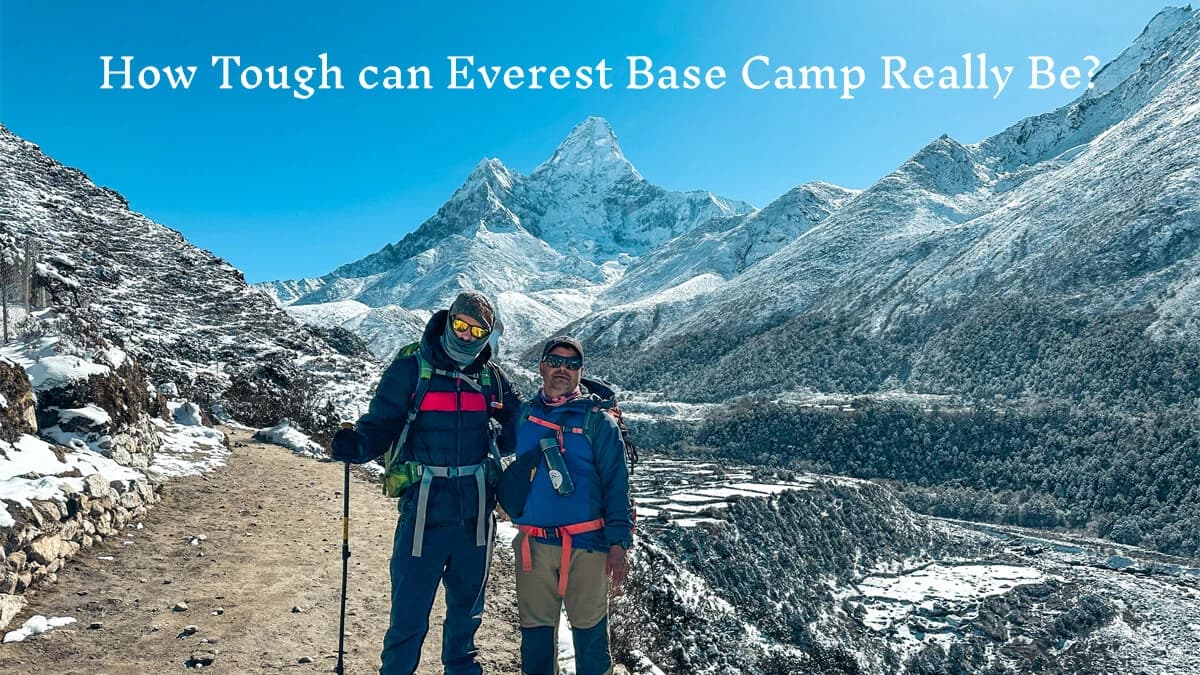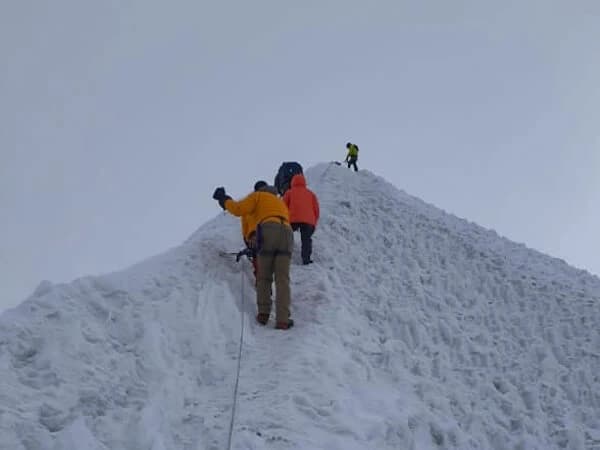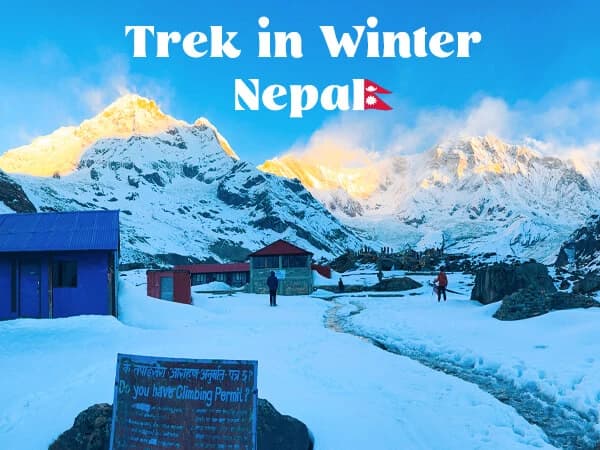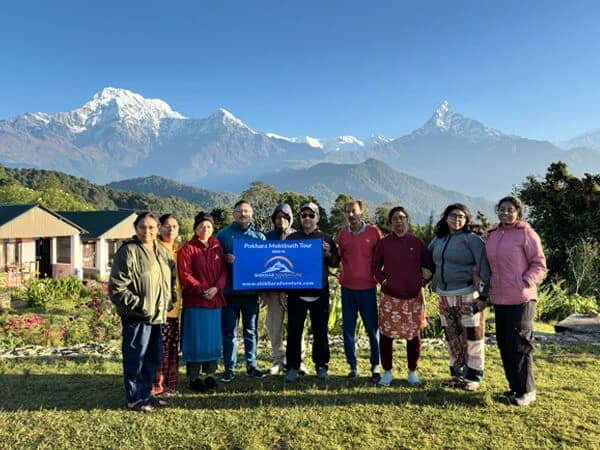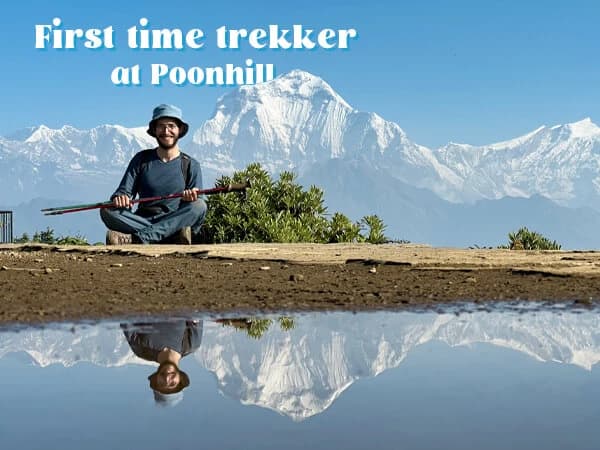How strenuous is the Everest Base Camp trek compared to other hikes?
“Everest Base Camp Trek” is one of the most famous ventures in the world. How difficult, though, is the Everest Base Camp hike compared to other well-known hikes? The short version: very difficult. You don't require any special climbing experience, but due to the rough terrain and unstable weather of high altitude, it is more difficult than most hikes at lower elevations
How Hard is Everest Base Camp Trek? Compare with Other Treks
If you've always wished to observe the world's highest mountain, the Everest Base Camp trek can facilitate your dream becoming a reality. It's not simply about observing Everest, but also about trekking along footpaths taken by renowned explorers, traversing suspension bridges over precipitous valleys, and enjoying hot tea in cozy mountain teahouses under some of the world's highest peaks.
So why do people hike this trek year-round? Because it's not simply a hike — it's a journey along Nepal's stunning Khumbu Valley, vibrant Sherpan culture, ancient monasteries, and spectacular vistas of the Himalayas. At every corner is another stunning vista or another warm encounter with people along the track.
This is not a fancy trip, and it is this which makes it so special. The Everest Base Camp trip tests your body, develops your mind, and provides you with a tale which you can tell forever.
What Makes the Everest Base Camp Trek a Life-Changing Journey?
The trek to Everest Base Camp is not so much about reaching somewhere — it’s about the moments that reach in and touch you along the way. Here’s why this trek is unique in another sense:
- At 5,364 meters (17,598 feet) beneath the towering Everest — It’s not where you reach; it’s where stories and dreams converge. The cool air fills your lungs, and each breath makes you think of the amazing thing that just happened.
- When you stand and look up at the sheer peaks of Everest, Lhotse, Nuptse, and Ama Dablam, you realize that they are more than just big rocks. They are ancient guards who watch over you and make you feel awe and respect every time the sun rises or sets.
- Individuals who trek in Sagarmatha National Park, which is a UNESCO World Heritage site, can observe the natural beauty of the area. The scent of rhododendron flowers makes the air pleasant, and one comes to know about the wild nature of these mountains through shy animals.
- Staying with Sherpas in such villages as Namche Bazaar and Tengboche is not simply relaxing. The villages are warm, full of stories, smiles, and decades of history. Colorful prayer flags and smiling people welcomed us into a country where religion and politics are tightly interwound. Each and every step you take is not only a step, but a step towards knowing yourself, becoming stronger, and creating memories which are eternal.

For what reason is the Everest Base Camp Trek hard?
The Everest Base Camp trek is difficult for a number of reasons:
- High Altitude: The camp is over 5,300 meters in elevation, and so trekkers frequently develop altitude sickness.
- Length and Duration: The average journey takes 12-14 days and travels a distance of 130 kilometers (80 miles) round trip.
- The weather can turn from sunny to snowy within a matter of hours.
- Basic Accommodations: The rooms are simple and do not have many modern amenities.
Despite all of this, proper preparation assists most good-condition hikers with completing the hike.
What makes the journey to Everest Base Camp different from other treks?
Numerous individuals query whether the Everest Base Camp trek is more difficult compared to some of the most famous treks in Nepal. It depends -- on how experienced you are, your level of physical fitness, and how well you acclimatize to high altitudes. Here are some of the most popular treks so you can compare them.
Everest Base Camp Trek v. Annapurna Base Camp Trek.
Both walks are pleasant, but they have different difficulties:
| Factor | Everest Base Camp Trek | Annapurna Base Camp Trek |
|---|---|---|
| Max Elevation | 5,364 meters | 4,130 meters |
| Trek Duration | 12–14 days | 7–10 days |
| Altitude Difficulty | High — requires careful acclimatization | Moderate — less risk of AMS |
| Physical Demands | Strenuous | Moderate to Strenuous |
| Accessibility | Lukla flight needed | Road access up to Nayapul |
Everest Base Camp vs Langtang Valley Trek
- Langtang is suitable for those with less time or those who prefer lower altitudes.
- The highest is 4,984 meters at Tserko Ri.
- Trek duration: 7–9 days.
- Physical demand: Average.
- Risk of altitude sickness: Lower compared to Everest.
Everest Base Camp and Manaslu Circuit Trek
- If you crave isolation and raw Himalayan landscapes, Manaslu is excellent — but tougher in some ways.
- Highest point: At Larya La Pass (5,160 meters)
- Trek duration: 14–16 days.
- Physical demand: Hard.
- The altitude risk is about the same as on Everest, but the climbs are steeper.
Trek to Everest Base Camp is difficult due to high altitude, long walking days, and distance away. It is more difficult than both the Langtang and the Annapurna treks but comparable to Manaslu. Yet with good physical shape and adaptation to the high altitude, it is a destination that most good trekkers can achieve.
Everest Compared to other worldwide popular treks
| Trek | Maximum Altitude | Duration | Difficulty Level |
|---|---|---|---|
| Everest Base Camp, Nepal | 5,545m | 12-14 days | Moderate to Hard |
| Annapurna Circuit, Nepal | 5,416m | 14-21 days | Moderate |
| Inca Trail, Peru | 4,215m | 4-5 days | Moderate |
| Kilimanjaro, Tanzania | 5,895m | 6-9 days | Hard |
| Tour du Mont Blanc, Europe | 2,665m | 10-12 days | Moderate |
The Everest Base Camp trek is difficult in terms of being high and long, but you do not require any climbing expertise.
How Difficult is the Daily Trekking Routine?
Most trekkers inquire, “How is a typical day spent on the Everest Base Camp trek?” Preparing mentally and physically is simpler when you understand what is in store. It is not solely climbing steep mountains but also walking long hours at altitudes, generally on rough and uneven trails.
Typical Daily Schedule
- Morning: You'll wake up between 6:00 and 6:30 AM. Most tea houses serve a simple breakfast menu, like porridge, eggs, toast, or pancakes, with tea or coffee. Between 7:30 and 8:00 AM, you'll start trekking.
- Typically, you will trek 5 to 7 hours a day. Distances might be short (8 to 15 km), but the steep upslopes, downslopes, and altitude slow you down. Frequent breaks are taken to enjoy tea, snacks, and taking photographs, which are necessary.
- Lunch: You'll be taking a mid-day break at a teahouse where you'll eat a hot plate of fried rice, noodles, or a plate of dal bhat (vegetables, lentils, and rice). This is an opportunity to rest and hydrate with water.
- Afternoon: You will walk for another 2–3 hours after lunch until you reach your overnight stay. Arriving by 3:00–4:00 PM is favorable to avoid afternoon winds and cold.
- Evening: After arriving at your lodge, most trekkers wash up, relax, or socialize with others in the dining room by a woodstove. Early dinner is served, 6:00 to 7:00 PM, followed by brief meetings regarding tomorrow's trail.
- People go to sleep in the evenings at an early time since they require sleep. Sleeping by 8:00–8:30 is quite normal, in part due to electricity and Wi-Fi being expensive or difficult to obtain.
Daily Physical Challenge:
- Elevation Gain: Most days involve gaining 300–600 meters in altitude, though some acclimatization days may see minimal gains with optional hikes.
- Trail Condition: Trails are various types, such as stone steps, rock terrain, suspension bridges, and wooded trails. Winter and spring are times when the upper sections could be snowy.
- Weather conditions are good in the mornings but cloudy and windy in the afternoons. It's cold at sunset.
The Everest Base Camp trek is a popular activity that requires patience, endurance, and a well-paced walk. Many hours of walking, acclimatization to high altitude, and varied weather can be challenging but extremely gratifying. New trekkers can perform well with a proper attitude.
What Physical Preparation is Needed?
You don't require any special mountain climbing expertise to hike to Everest Base Camp, but you must be in good physical shape. Hiking to Everest Base Camp doesn't involve ropes or special shoes, but it tests you and compels you.
Preparing ahead of time keeps you less tired, makes this wonderful journey a delight, and acclimates your body to be at high altitudes. More importantly, it reduces the likelihood of falling ill from high altitudes, such as Acute Mountain Sickness (AMS).
Here is how you can prepare:
-
Cardiovascular Endurance:
Do 4 or 5 cardiovascular exercises per week. Some examples are running, hiking, brisk walking, swimming, and cycling. Gradually increase the duration and intensity of your workouts over 2 to 3 months.
-
Building strength:
Having good legs and a good core are crucial. Do lunges, squats, deadlifts, and planks. Incorporate two strength training days in your schedule to develop calf and thigh endurance.
-
Practice walking with a backpack:
Try to simulate actual hiking conditions as much as possible. Make long walks in a heavy backpack (5-8 kg) to acclimatize yourself to walking hills and mountains several hours a day. You can also break in your EBC trekking boots this way.
-
Acclimatization Plan:
Not everybody can acclimatize to high altitudes prior to the trek, but a few days over 2,500m on less demanding treks (such as Langtang or Poon Hill) is beneficial. It helps your body and lungs work better when you breathe in less air.
-
Flexibility and Recovery:
Stretching or yoga makes your muscles move smoothly and feel good. A good night's rest and a lot of water intake during training makes you recover quicker and perform well.
Training for 8-12 weeks will assist you a great deal. It prepares you, both physically and mentally—making the Everest Base Camp trek an enjoyable experience rather than a gruelling challenge.
If you want a detailed packing list for the Everest Base Camp trek, including gear recommendations and advice, see our full guide here.

What is the Altitude Challenge Like?
The hardest part of the Everest Base Camp Trek is being at such a high elevation. It begins at a height of approximately 2,800 meters in Lukla and reaches 5,364 meters in Base Camp. The air is thinner and you receive less oxygen per breath when you go higher. This is where the greatest challenge confronts most trekkers.
Some people wonder, "Is hiking at very high altitudes dangerous?" The answer is "yes," but only if you're not ready. The greatest concern is not so much the work you'll do, but how your body will adapt to high elevations. Even strong hikers can experience altitude sickness, so it is best to learn about it and how to deal with it.
Key altitude facts you ought to know:
- Everest Base Camp has 40–50% thinner air than sea level. This makes it quite exhausting to take even a single step, particularly while ascending.
- Headaches, nausea, tiredness, loss of appetite, and trouble sleeping are all common signs of altitude sickness.
- Getting used to living at high levels helps your body work better. The trekking routes also include rest days in towns such as Dingboche and Namche Bazaar.
To control the height:
- Go slow: Walk slowly, even if you are physically fit.
- You should drink at least 3 to 4 liters of water every day during your trek.
- Watch your body: If you're getting worse, it's safer to go down than to chance getting extremely sick.
- Don't consume alcohol or smoke during treks.
If they prepare properly, most trekkers perform well on the Everest Base Camp trek. It simply amounts to respecting the mountain's altitude rules and adjusting your itinerary if necessary.
Everest Base Camp Trek Challenges Nobody Tells You About
Trekking to Everest Base Camp isn’t just a walk in the mountains — it’s a mental, physical, and emotional game played at high altitude. Sure, you’ve probably heard about altitude sickness and the cold. But let’s get a little deeper and more real about what makes this journey one of the most unforgettable (and challenging) adventures on earth.
-
1. The Mental Tug-of-War
Forget the Instagram-perfect views for a moment. There’ll be times when your legs feel like concrete, your lungs are gasping for thin air, and your mind will whisper “Why am I doing this?”. The biggest challenge isn’t the trail — it’s convincing yourself to take one more step when everything says stop. And trust me, this will happen more than once.
-
2. The Thin-Air Reality Check
Altitude isn’t just a number. At 5,000+ meters, your body reacts in weird ways. Simple tasks like tying your shoelaces or zipping your jacket can leave you breathless. Nights become restless, and even though you’re exhausted, sleep feels like a rare luxury. Some trekkers get headaches, lose their appetite, or start questioning life decisions at 3 AM inside a cold teahouse room.
-
3. Cold That Crawls into Your Bones
You can feel the cold in your bones as well as on your skin. Early mornings and nights at places like Gorak Shep and Lobuche can drop below -15°C, and no amount of down jackets and thermal socks completely save you. The real challenge? Crawling out of your warm sleeping bag for a midnight bathroom break when the icy wind hits your face like needles.
-
4. The Never-Ending Uphills (and Downhills)
The Everest Base Camp trail isn’t a steady climb up to Base Camp and an easy way down. It’s an unforgiving rollercoaster. One moment you’re descending a thousand feet, the next you’re climbing it back. The stretch from Namche to Tengboche will test your patience, while the Kala Patthar climb at dawn might just push you to your edge. Your legs will scream. But your heart will keep chasing those Himalayan views.
-
5. Teahouse Food Fatigue
In the beginning, dhal bhat power is real. You’ll love the warm plates of rice, lentils, and vegetables. But after day five, when every menu starts to look identical, your cravings for a juicy burger, fresh salad, or your favorite snacks back home will hit hard. Some trekkers dream about food more than Everest itself!
-
6. The Digital Detox You Didn’t Sign Up For
Wi-Fi exists… technically. But it’s patchy, slow, and expensive. And as you go higher, connectivity vanishes altogether. For some, it’s a peaceful detox. For others, it’s a maddening test of patience in a hyper-connected world. Prepare to be fully present in every moment — whether it’s breathtaking or bone-chilling.
-
7. The Weight of Expectation
Let’s be honest. Everyone back home expects heroic tales and summit-like photos. That pressure can weigh heavier than your backpack. Especially on tough days when you’re battling headaches, fatigue, or self-doubt. The challenge is learning to trek for yourself — not for social media, not for anyone else’s expectations.
The Everest Base Camp Trek is more than just getting to a specific location. It’s about battling yourself, adjusting to unpredictability, and discovering how far you’re willing to go. The views are epic, yes. But it’s the invisible battles you fight along the way that make this trek legendary. And that’s what nobody tells you about.
Is the Everest Base Camp Trek Safe?
Yes — if you go hiking with a reputable agency and observe safety regulations. The most serious danger is altitude sickness, but if you allow yourself time to acclimate and stay hydrated, it can be managed.
Safety Tips
- Hike with experienced guides.
- Stay hydrated and eat nutritious meals.
- Listen to your body and gradually increase your effort.
Our Everest Base Camp Trek Package includes licensed guides, rest days for altitude acclimatization, and emergency assistance.
Why Pick Everest Base Camp Trek?
Nepal has numerous treks, and you may be thinking, “Why go on the Everest Base Camp trek instead of another one?” It is the combination of well-known mountain vistas, rich Sherpa heritage, and significant history on the path that makes it unique. It is not simply a trek — it is an experience you will never forget.
Reasons for Trekking to Everest Base Camp:
- Stand before the world's tallest mountain: Can you count yourself with those people who stood in front of Everest? Just getting to 5,364 meters at the Base Camp, even if you are not climbing, is a small but unique sensation.
- Trek through traditional Sherpa communities: Visit Namche Bazaar, Tengboche, and Dingboche. These villages are living cultural sites where you will witness ancient mountain cultures, Buddhist rituals, and warm hospitality.
- Visit notable monasteries: Everest, Ama Dablam, and Lhotse stand behind Tengboche. The monastery here is the most photographed religious site in the Himalayas.
- Trek famous routes: Hike the same trails followed by renowned mountaineers like Sir Edmund Hillary and Tenzing Norgay. Each rock and prayer flag carries history.
- Enjoy stunning mountain views: Experience breathtaking sights of Everest, Lhotse, Nuptse, Ama Dablam, Thamserku, and Pumori. Sunrise from Kala Patthar (5,545m) offers arguably the best close-up view of Everest without climbing it.
- Challenges and adventure: The trek tests your physical and mental limits. Completing it brings a unique sense of achievement unmatched by many other treks.
Whom Is It For?
- New hikers looking for a popular guided mountain tour.
- Nature lovers seeking breathtaking Himalayan vistas.
- Culture enthusiasts interested in Buddhist monasteries and Sherpa heritage.
- Adventurers seeking a moderately tough expedition with significant rewards.
The Everest Base Camp trek is an excellent combination of exercise, culture, and scenery. It is a wonderful choice for trekkers looking to hike to Everest and experience Nepal's renowned mountain villages and trails.
Though challenging, reaching Everest Base Camp is well worth the effort. The high altitude and primitive facilities are the real challenges, but with proper preparation, most fit individuals will cope well. This trek stands out for the richness of its cultures, renowned mountain vistas, and the strong sense of accomplishment it provides.
Conclusion
If you are interested in hiking in and around Everest and experiencing some of the most breathtaking views in the world, this trek is ideal for you. Proper planning and a reputable trek company like ours can ensure that your hike to Everest Base Camp is safe, unforgettable, and life-altering.
Are you ready to begin this wonderful adventure?
👉 Contact us today to reserve a trip to Everest Base Camp!



